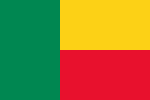Religion in Benin
| Part of a series on the |
| Culture of Benin |
|---|
 |
| People |
| Languages |
| Mythology |
| Cuisine |
| Religion |
| Art |
| Literature |
| Music |
| Sport |
Religion in Benin (2020 estimate)[1]

Christianity is the largest religion in Benin, with substantial populations of Muslims and adherents of traditional faiths.
According to the most recent 2020 estimate, the population of Benin is 52.2% Christian, 24.6% Muslim, 17.9% traditionalist and 5.3% follows other faiths or has no religion.[2][3]
Overview
[edit]There are Christians, Muslims, and adherents of African traditional religions throughout the country.[4] However, most adherents of the traditional Yoruba religious group are in the south, while other African Traditional Religion beliefs are followed in the north.[4] Muslims are represented most heavily in the north, while Catholics are prevalent in the south,[5] particularly in Cotonou, the economic capital. It is not unusual for members of the same family to practise Christianity, Islam, African Traditional Religion, or a combination of all of these.


Faiths
[edit]African traditional religions
[edit]Among the most practiced African traditional religions in Benin is the Vodun system of belief which originated in this area of Africa.[5]
Other African traditional religions are practiced in the Atakora (Atakora and Donga provinces) and Vodun and Orisha (or Orisa) veneration among the Yoruba and Tado peoples is prevalent in the centre and south of the country. The town of Ouidah on the central coast is the spiritual centre of Beninese Vodun.
The Tado and the Yoruba Orisha pantheons correspond closely:
- The supreme deity Mawu (in the Fon language) or Olodumare (also known as Olorun, Eledumare, Olofin-Orun and Eledaa among other names)(in Yoruba)
- The deity of the earth and smallpox, known as Sakpana (or Sopono, Sakpata), can also be spelt as 'Shakpata, Shopono, Shakpana, and also known as Babalu Aye or Obalu Aye.
- The deity of thunder and lightning, known as Shango; can also be spelt as Sango, also known as Jakuta, Chango, Xevioso and Hevioso.
- The deity of war and iron, known as Ogun, also known as Ogoun or Gu.
Christianity
[edit]Catholicism first reached Benin in 1680, gaining more permanent footing in the 19th century. English Methodists arrived in 1843, operating amongst the coastal Gun people.[6] French missionaries spread Catholicism in the region.[7]
More than half of all Catholics in Benin are Roman Catholic.[8] The Catholic hierarchy in Benin consists of the Archdiocese of Cotonou (including the Dioceses of Abomey, Dassa-Zoumé, Lokossa, Porto Novo) and the Parakou (including the Dioceses of Djougou, Kandi, Natitingou, and N'Dali). In 2020, there were 1349 priests and 1482 women in religious orders.[9]
Other Christian groups include Celestial Christians, Methodists, the Church of Jesus Christ of Latter-day Saints (Mormons), Jehovah's Witnesses, Baptists, Pentecostals, the Unification Church and the Very Holy Church of Jesus Christ of Baname.[5]
Islam
[edit]
Islam, which accounts for more than 27% of the country's population, was brought to Benin from the north by Hausa, and Songhai-Dendi traders.[7] Nearly all Muslims adhere to the Sunni branch of Islam.[5] The few Shi'a Muslims are primarily Middle Eastern expatriates.[4] Shia population in Benin is estimated between one and twelve percent of the total Muslim population of Benin, according to Pew Forum it is less than one percent[11] while as per Ahl al-Bayt World Assembly the population of Shia in Benin is around twelve percent of the total Muslim population of Benin.[12] Ahmadiyya Muslim Community is also present, who recently inaugurated a mosque in Benin, the Al Mahdi Mosque in 2006. Many nominal Muslims also practise traditional local religious beliefs.[4]
-
Mosque in Porto-Novo
-
Islamic art in Benin
-
Pilgrims leaving for Mecca
Three out of twelve departments have a Muslim majority: Alibori (81.3%), Donga (77.9%) and Borgou (69.8%).[13] Couffo has the lowest share of Muslims in Benin as Muslims comprise less than 1% of the total population.
Other groups
[edit]Other religious groups in Benin include Eckankar and followers of the Baháʼí Faith.[5]
Freedom of religion
[edit]The Constitution of Benin provides for freedom of religion, and the government generally respects this right in practice.[5] The United States government recorded no reports of societal abuses or discrimination based on religious belief or practice during 2007, and prominent societal leaders have taken positive steps to promote religious freedom.[4]
In 2023, Benin was scored 4 out of 4 for religious freedom.[14]
See also
[edit]- Christianity in Benin
- Catholic Church in Benin
- Protestant Methodist Church in Benin
- Freedom of religion in Benin
References
[edit]- ^ "Religions in Benin | PEW-GRF". Archived from the original on 17 October 2021. Retrieved 17 April 2021.
- ^ "The World Factbook - Central Intelligence Agency". www.cia.gov. Retrieved 2018-08-20.
- ^ "Benin". US State Dept 2021 report. Retrieved 2022-11-11.
- ^ a b c d e International Religious Freedom Report 2007: Benin. United States Bureau of Democracy, Human Rights and Labor (September 14, 2007). This article incorporates text from this source, which is in the public domain.
- ^ a b c d e f US State Dept 2022 Religious Freedom Report: Benin.
- ^ Serving In Mission website
- ^ a b Skutsch, Carl, ed. (2013). Encyclopedia of the World's Minorities. Routledge. p. 210. doi:10.4324/9780203935606. ISBN 978-1-135-19388-1.
- ^ The ARDA website, retrieved 2023-08-01
- ^ Catholics And Culture website, retrieved 2023-08-01
- ^ "RGPH_Principaux indicateurs socio démographiques et économiques". Open Data for Africa. 2016. Retrieved August 25, 2022.
- ^ "Estimated Percentage Range of Shia by Country" (PDF). Pew forum. Archived from the original (PDF) on 1 August 2012. Retrieved 30 July 2013.
- ^ "Shia Population in: Benin". The AhlulBayt World Assembly. 8 April 2010. Retrieved 1 August 2013.
- ^ https://www.insae-bj.org/images/docs/insae-statistiques/demographiques/population/Principaux%20Indicateurs%20avec%20projections%20RGPH4/Principaux%20indicateurs%20socio%20démographiques%20et%20économiques%20RGPH-4.pdf [bare URL PDF]
- ^ Freedom House website, Retrieved 2023-08-01





